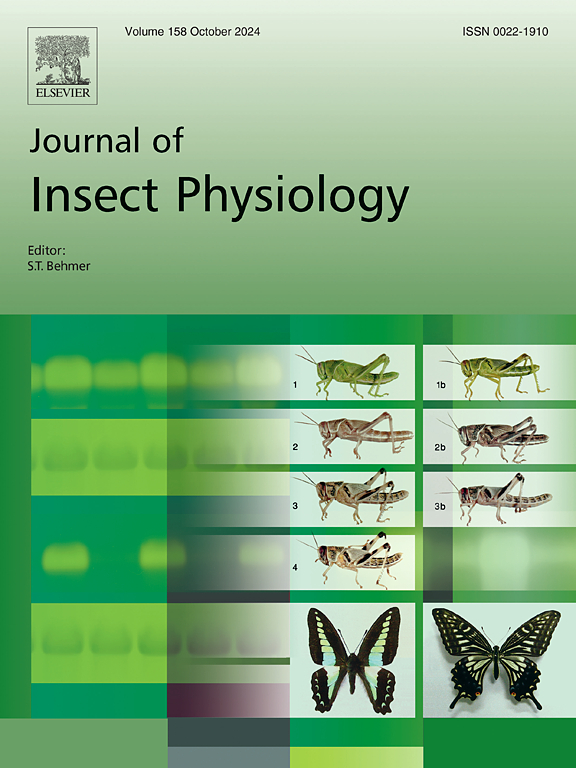温度和湿度对滞育和非滞育埃及伊蚊卵存活和孵化反应的影响。
IF 2.3
2区 农林科学
Q1 ENTOMOLOGY
引用次数: 0
摘要
在季节变化的环境中,由较短的光周期引起的滞育有利于许多昆虫越冬。在伊蚊中,胚胎滞育与更高的存活率和对低温和低湿度的抵抗力有关。登革热和其他虫媒病毒的主要媒介埃及伊蚊最近向温带地区扩大了分布。其中一个可能有利于南美洲这种扩张的机制是诱导胚胎滞育的能力。最近在阿根廷的种群中发现了这种类型的滞育,这与孵化抑制和卵中脂质的增加有关。本研究的目的是评估不同湿度和温度条件下滞育(D)和非滞育(ND)卵的4个月存活率。研究分析了阿根廷温带地区的两个人群:一个来自布宜诺斯艾利斯(BA),一个冬天相对温和和短暂的城市,另一个来自圣贝纳多(SB),一个冬天更严酷和更长的地方。两个种群分别在10:14 L:D和14:10 L:D维持的菌落中获得D和ND卵。鸡蛋暴露在六种不同的湿度和温度条件下85 天。暴露后,分析卵存活率和孵化反应。D卵在低湿度(2个种群)和中、高湿及低温条件下(SB种群)的成活率显著提高。此外,在高湿低温条件下,D卵的孵化响应显著降低,2次浸泡后未孵化卵的存活率均较高。SB的D蛋对低温的耐受性显著高于BA的D蛋。来自SB的ND蛋对低温的耐受性显著提高,而来自BA的ND蛋对低湿的耐受性显著提高。总的来说,滞育的影响是浸泡后未孵化的活胚数量显著增加。结果表明,Ae。埃及伊蚊诱导卵滞育增加了成功越冬的可能性,并进一步扩大了其分布范围,因此在温带地区虫媒病毒传播的风险可能增加。本文章由计算机程序翻译,如有差异,请以英文原文为准。

Effects of temperature and humidity on the survival and hatching response of diapausing and non-diapausing Aedes aegypti eggs
In seasonally varying environments, diapause, which is induced by a short photoperiod, favors overwintering of many insects. In Aedine mosquitoes, embryonic diapause is associated with higher survival and resistance to low temperature and humidity. Aedes aegypti, the main vector of dengue and other arboviruses, has recently expanded its distribution towards temperate regions. One of the mechanisms that might have favored this expansion in South America is the ability to induce embryonic diapause. This type of diapause has been recently discovered in populations from Argentina, associated with hatching inhibition and increased amounts of lipids in the eggs. The aim of this study was to assess the four-month survival of diapausing (D) and non-diapausing (ND) eggs stored at different humidity and temperature conditions. Two populations from the temperate region of Argentina were analyzed: one from Buenos Aires (BA), a city with a relatively mild and short winter, and another from San Bernardo (SB), a locality with a harsher and longer winter. For both populations, D and ND eggs were obtained from colonies maintained under 10:14 L:D and 14:10 L:D hours respectively. Eggs were exposed to six different conditions of humidity and temperature for 85 days. After exposure, egg survival and hatching response were analyzed. D eggs showed significantly higher survival at low humidity (both populations), and at medium and high humidity and at low temperatures (SB population). In addition, D eggs showed a significantly lower hatching response at high humidity and low temperatures, and higher proportion of not hatched eggs remaining viable after two immersions under all conditions. D eggs from SB were significantly more tolerant to low temperatures than those from BA. ND eggs from SB were significantly more tolerant to low temperatures, while those from BA were more tolerant to low humidity. Overall, the effect of diapause was a significant increase in the number of not hatched, viable embryos after immersion. Results suggest that the ability of Ae. aegypti to induce egg diapause increases the probability of successful overwintering and further expansion of its distribution range, and as a consequence the risk of arbovirus transmission might increase in temperate areas.
求助全文
通过发布文献求助,成功后即可免费获取论文全文。
去求助
来源期刊

Journal of insect physiology
生物-昆虫学
CiteScore
4.50
自引率
4.50%
发文量
77
审稿时长
57 days
期刊介绍:
All aspects of insect physiology are published in this journal which will also accept papers on the physiology of other arthropods, if the referees consider the work to be of general interest. The coverage includes endocrinology (in relation to moulting, reproduction and metabolism), pheromones, neurobiology (cellular, integrative and developmental), physiological pharmacology, nutrition (food selection, digestion and absorption), homeostasis, excretion, reproduction and behaviour. Papers covering functional genomics and molecular approaches to physiological problems will also be included. Communications on structure and applied entomology can be published if the subject matter has an explicit bearing on the physiology of arthropods. Review articles and novel method papers are also welcomed.
 求助内容:
求助内容: 应助结果提醒方式:
应助结果提醒方式:


